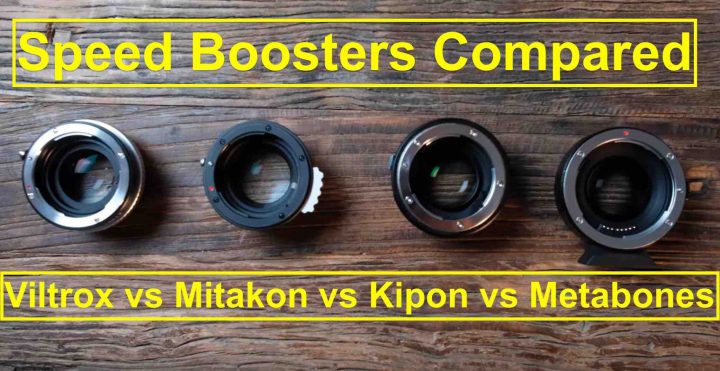Which Speedbooster for Fujifilm is Best? Kipon vs Metabones vs Mitakon vs Viltrox

There are lots of adapters for the Fujifilm X system, including focal reducers, which work like this: you take a Full Frame lens, puts them on Fuji APS-C sensor, and the speedbooster transmutes that focal length back to full frame. It totally negates the crop factor. And the way the adapter works, we actually also double our light, translating 1 stop faster in exposure time.
Andrew compares four focal reducers or speed boosters:
- Kipon Baveyes EF/X 0.7x
- Metabones Speed Booster XL 0.64x
- ZHONGYI Mitakon Lens Turbo Adapter V2
- Viltrox EF-FX2 Auto Focus 0.71x
Here are Andrew’s thoughts (video below):
Focal Reducers Compared
Down below a summary in case you are in a hurry right now and don’t have time to watch it. But make sure to watch the video below as soon as you have time, so you can listen to it and see the sample Andrew shares.
Handling & Use
- the Kipon is a pain to get on and off the lens, such a tight fit. Requires so much torque to get it loose
- the Metabones has a build-in clickless adapter ring, and it’s confusing to use in conjunction with the aperture ring on the lens (which has to be stopped down totally, or changing aperture on the adapter won’t work and vice versa, if you want to use the aperture ring on the lens)
- the Viltrox, when you are focusing or changing settings, it acts strange trying to interact with Fujifilm’s firmware, and tends to flicker to white and black. If you want to use AF, that’s something you can live with, but if you use it for manual focus only, it can be annoying. Autofocus unreliable and sluggish
- the Mitakon didn’t cause him any grief, at least until he looked at image quality
Sharpness
- he uses the older Nikkor 50mm f/1.4 for the test on all adapters, except Viltrox, which is only available for Canon, and hence he tests the more modern Canon 50mm f/1.4 on the Viltrox
- Kipon vs Mitakon: wider open neither is very good. Kipon is less blurry, but has more fringing. In the corners, the Mitakon mantains sharpness better than the Kipon, which is noticably worse. The Kipon has also more distortion. At F8 the Kipon is much more sharp in the center, but less sharp than the Mitkon in the corners. Overall winner is the Kipon
- Kipon vs Metabones: wide open both are not sharp at the center, but Metabones wins and has less fringing. Metabones is also superior in the corners, sharper and less distortion. Also stopped down the Metabones wins
- Viltrox using Nikkor 50mm f/1.4 vs Canon 50mm f/1.4: The Canon is noticeably sharper in the corners
- Metabones vs Viltrox: wide open, the modern Canon 50/1.4 is a bit sharper than the Metabones, while at the edges they look fairly similar (not that great). At F4 the center sharpness is very similar, with Viltrox performing a little bit better. In the corners, the Viltrox is a lot sharper, but we saw before that the modern Canon 50/1.4 is sharper than the vintage Nikkor 50/1.4. Overall a draw
Bokeh
- Bokeh is not great on all four adapters. On all four doubling can occur at certain distances behind the subject. In general some really nervous background, but some people like that look
- the Viltrox is overall smoother, but it could be largely thanks to the Canon 50mm f/1.4
- no clear winner
Which one to get?
- not the Mitakon, due to poor IQ
- not the Kipon, due to poor IQ, but even more because of how difficult it is to get on and off the lenses
- Viltrox and Metabones are the best bet
- Overall adapters degrade image quality quite a bit
- can be a problem when cropping, except if you crop right in the center (and keep vignetting consistent over the image)
- for low light shooting, he will keep the Metabones speed booster to use his fast Nikkor lenses on the Fuji cameras and keep ISO lower. He is willing to sacrifize sharpness to manage noise
Speaking of adapters, we remind you that Fuji Guy Billy told us recently here, only Kipon, Fotodiox and Metabones have the right specs to communicate with the body (and hence are under NDA from Fujifilm).

